Climate change has the potential to influence the distribution and behavior of disease vectors such as mosquitoes and ticks. Warmer temperatures and shifting precipitation patterns can broaden these vectors’ geographic ranges, exposing previously unaffected people to diseases including malaria, dengue fever, Zika virus, and Lyme disease.
A recent European study looked at the incidence of protozoans, bacteria, and viruses that could be dangerous to humans and domestic animals in birds and bats under different climatic circumstances. Many of these diseases’ prevalence was linked to temperature or rainfall.
The new study gathered data on the presence of over 75 harmful microorganisms in Europe from around 400 birds and 40 bat species. Combining data on occurrence with climatic conditions revealed that most viruses’ occurrence was related to temperature or rainfall.
“In general, the occurrence of pathogenic bacteria increased in hot, dry climates.” Pathogenic viruses, on the other hand, like damp climates,” says lead scientist Yanjie Xu of the Finnish Museum of Natural History at the University of Helsinki. On the 17 pathogen taxa with the most data, the relationship between climatic conditions and pathogens may be explored. The observed relationships were diverse.
The temperature was positively associated with the occurrence of avian flu virus, malaria -parasite, and bacteria that cause chlamydia, salmonella, Q-fever, and typhus in birds and bats.
Arto Pulliainen
“Temperature was positively associated with the occurrence of avian flu virus, malaria -parasite, and bacteria that cause chlamydia, salmonella, Q-fever, and typhus in birds and bats,” explains university lecturer Arto Pulliainen from the University of Turku Institute of Biomedicine.
Rainfall had both positive and negative relationships with the incidence of infections. Increased rainfall, for example, increased the likelihood of the prevalence of Usutu-, Sindbis-, and avian flu viruses, as well as the occurrence of salmonella bacteria.
“Usutu- and Sindbis-viruses are vectored by mosquitoes, and rainfall can increase the occurrence of wetlands that mosquitoes prefer. Similarly, avian flu and salmonella are frequent, notably among waterfowl, for whom wetlands are also important,” explains academy research fellow Thomas Lilley of the Finnish Museum of Natural History.

The study, which compiled the findings of over 700 research publications and over half a million observations, supports the idea that climate change can modify the risk of contracting infectious diseases. Climate change alters the distribution ranges of diseases as well as their hosts, wild animals. Bird distribution ranges have already been detected shifting northwards by more than a kilometer every year. Climate change also has an impact on the occurrence of diseases in the environment, such as in bodies of water.
“There is a possibility that thermophilic pathogens, for example, will become more common in northern Europe as a result of climate change,” says Aleksi Lehikoinen, senior curator at the Finnish Museum of Natural History.
The study was published in Ecography, a merited scientific journal, and was funded by a grant from the Academy of Finland “Climate Change and Health”- a research program to a research consortium consisting of members from the University of Helsinki and the University of Turku.
















